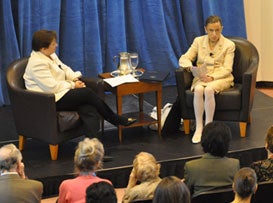US Supreme Court Justice Ruth Bader Ginsburg, who attended the law school from 1956 to 1958, was the star attraction of Celebration 55, a four-day event which drew 600 alumnae, students and guests and marked the 55th anniversary of female enrollment at the law school.
In a Saturday conversation with Dean Elena Kagan ’86 in Pound Hall, the justice discussed topics ranging from the role that foreign law should play in the Court’s deliberations to the present ideological split on the Court reflected by the number of 5-4 decisions in major cases.
As a prelude to her Q&A with the dean, Ginsburg offered a cameo portrait of Belva Lockwood, whom she described as “a resourceful woman who in 1879 made the Supreme Court change its ways.” Lockwood, the first woman ever to gain admission before the Supreme Court and the first woman to run for president of the United States, paved the way for many of today’s female jurists and leaders, Ginsburg said. But she added: “The presence of only one woman on the current Supreme Court bench indicates the need for Lockwood’s sense and steel for change.” (Watch a webcast of the discussion.)
The justice said it was important for women to know the stories of pioneers like Lockwood. “We should appreciate the women on whose shoulders we stand.”
Kagan opened the conversation by asking the justice what she was thinking about as she looked ahead at a new Supreme Court term. “Hoping I can get the 5th vote,” Ginsburg answered.
“The first full year that Justice [Sandra Day] O’Connor was absent, every 5-4 decision where I was in dissent, I would have been in the majority [had O’Connor still been there],” said Ginsburg. “But the 5-4 decisions can be revisited and many have been. I spend as least as much time on my dissenting opinions as I do on my opinions for the Court. And I am hopeful that one day those opinions will represent the views of the Court.”
On her status as the only woman on the Court now that O’Connor is gone—and on the prospects for another woman appointee—she said: “Our neighbor to the North, I think, now has 4 women out of 9. Looking at our state supreme courts, some of them even have a majority of women. The problem with the Supreme Court is there is no compulsory retirement age, and when you think of who is going to leave, not my younger colleagues who are in their 50s … The oldest justice is Justice John Paul Stevens, if he should leave us, he might well be replaced by a woman, but frankly, I’m not in a hurry to see him go. I’m the next oldest. So it would be a like-kind replacement.”
When asked why and when she chooses to deliver dissents orally from the bench, the justice replied: “If you think the court has not just gone wrong, if you think it’s gone wrong egregiously so, that’s when you read your opinion from the bench. And it may be that you have another forum in mind.” She cited the 2007 case of Ledbetter v. Goodyear Tire & Rubber Co. There, in a 5-4 decision, the Court, taking a highly restrictive view of Title VII, severely limited the ability of women and others to bring EEOC claims alleging discriminatory pay practices.
“I had a particular audience. It was Congress. And it was saying, in effect, ‘Congress you could not have meant what this Court thinks you meant, so fix it,’” she said.
When Kagan raised the waning influence of Supreme Court decisions on international courts, Ginsburg replied: “I have often said, if we don’t listen, we won’t be listened to.” She added: “It makes no sense to me that it would be somehow unpatriotic to look beyond our borders for enlightenment.”
Several of the 13 women in the 500-person law school class of 1953 were present.
